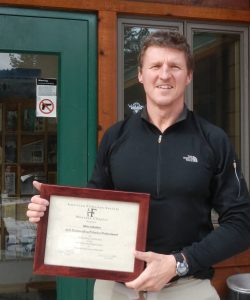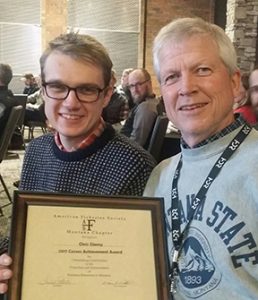
By Michael Howell
Two fisheries biologists in the Bitterroot, Mike Jakober working for the Bitterroot National Forest and Chris Clancy working for Montana Department of Fish Wildlife and Parks, brought home awards from the Montana Chapter of the American Fisheries Society’s annual meeting held recently in Butte.

The theme of the 137th annual meeting was: management across jurisdictional boundaries; working together to get the big and small jobs done.
That’s exactly what Jakober and Clancy do here in the Bitterroot. They work together to get the big and small jobs done. In fact, to say the agencies work closely together, in this case, is an understatement. In the Bitterroot, the FWP biologist shares an office with the Forest Service at the Supervisors Headquarters in Hamilton.
Clancy said it wasn’t just office space that was shared. He said he shared the same database as the forest biologists, they shared crews in the field, they share equipment and they cooperate in plans.
“We’ve got about as cooperative a program as anywhere in the state,” said Clancy. “It makes sense,” he said, “because essentially we are working on the same fishery.”
Jakober delivered a talk at the American Fisheries Society meeting on the subject.
He also received, to his surprise, the “Outstanding Fishery Professional Award.” The award is, in part, given out for “efforts that go ‘above and beyond’ job requirements.”
Jakober said, “I’ve never won an award at an American Fisheries Society meeting before, so I wasn’t expecting it. I’m honored. It’s nice to know that people recognize that you are doing a good job. But basically, I’m getting an award for just doing what I’m supposed to do. I don’t think I’m doing anything above and beyond my job.”
But if it’s not “above and beyond” in Jakober’s view, that may have something to do with how high he sets the bar for “just doing his job.” His work certainly meets the other award criteria which include “demonstrating creativity and innovation; promoting sound aquatic resource management outside the fishery profession; influence in dealing with local, state, or federal government entities for ensuring the future welfare of Montana’s aquatic resources; demonstration of a long-term commitment to Montana’s aquatic environment, or to a particular lake, river, or stream; elevating public interest and awareness in fishing and fishery management; inspiring and encouraging others to pursue the conservation and restoration of aquatic resources.”
Jakober started working on the Bitterroot National Forest seasonally in 1991 and started full time in 1995. The first four years he worked out of Stevensville as the North Zone biologist but the last 18 years he has been stationed in the South Zone working out of Sula and the West Fork.
“So basically, I’ve spent my entire Forest Service career working on the Bitterroot,” said Jakober. “I like it that way.” He said he very much enjoys being an expert on Bitterroot streams.
Asked about the difference between the north zone and the south zone, he said first off that the south zone had a lot more area.
“It’s got the Selway drainage which is just about as good a block of reference condition, encatched streams as you could find anywhere in the lower 48,” he said.
He said the East Fork and the West Fork are both good fisheries. He said compared to the mainstem from where the forks meet down to Hamilton, the cutthroat are in pretty good condition. There are not as many non-native rainbow and brown trout. He said as you move northward the river warms up and there are more rainbow and browns. He said there were hardly any bull trout north of Hamilton. There are still cutthroat but not as many as in the south end of the valley in colder waters.
“The south end of the valley is a more intact fishery for sure,” he said.
Asked about any noteworthy changes he may have noticed over the years, Jakober said, “The main thing in my career is the effect of fire.” He said he had spent a lot of time since 2000 monitoring fire effects and post fire recovery.
He recalls that the first really big fire on the forest that he remembers was in 1994 and then another in 1996 in the Selway. That fire, the Sweat Fire, was about 47,000 acres.
“It was a lot of high severity burn,” he said. “It was a big deal back then. I’d never seen anything like it. A lot of my co-workers had never seen anything on that scale. Nowadays, we are so conditioned to it that I don’t think it would amount to more than a blip on the radar screen.”
He rattled off the names of fires that have since swept through the forest, Observation, Roaring Lion, Gold Pan, Saddle, and Rombo…” He said they have all kind of blurred together and if you look at a map with the fire history overlaid, “It’s a splotchy, speckled mess of overlapping colors.”
As a result, he said, he sees a lot more open non-forested habitat on the forest than there used to be, to the point that, “some places, I think, are undergoing site conversion, where we are not going to have a forest there in the future.” He said parts of the Bitterroot could come to look more like the area around Salmon and Challis. Some big open grasslands, still some trees but higher up the hills.
He said a lot of our streams are getting warmer and brushier without as many conifers along them. He pointed out how Rye Creek, which was a Spruce bottom before the 2000 fires, is now a deciduous ecotype, with mountain maple, alder, aspen, and cottonwood, with just a few conifers here and there.
“There is a lot there that I’m wondering if it will ever become conifer covered again like it used to be,” he said. “I think we have converted to another kind of ecosystem there.” He said it has happened elsewhere across the forest too.
“That’s the biggest change I’ve seen,” he said.
The large forest fires can have a huge impact on local fisheries, changing the population ratio of the various species. For instance, there was a remnant population of Bull trout in North Rye Creek before the fires of 2000 and the bulk of the remaining population was made up of two-thirds Brook trout and one-third Westslope Cutthroat trout. After the fires no Bull trout were left and Westslope Cutthroats comprise 95% of the fishery.
Jakober said, simply, that the native cutthroats are a fire adapted species and their populations rebound incredibly swiftly after fires. He said, “Brookies don’t do so well.” He said the few places where Brook trout seem to be doing well after the fire also have a lot of beaver dams and there may be some connection there.
Jakober said his gut instinct is that the fires are climate change related. He said as climate change advances he thinks our forests will come to look more like forests to the south of us right now, with more grassland, more brush, and less conifers growing higher up the slopes.
“This is just my gut feeling from what I’ve seen,” he said. “We have seen a lot of change over the last twenty years. If you accelerate that change over the next century, it’s going to look really different.”
Jakober said that a lot of data on water temperature in the Bitterroot River and its tributaries has been collected and when graphed shows a steady increase in temperature over the last twenty-five years across the board.
“It’s got to be a climate trend,” said Jakober, “when you see the same sort of increase all over the place in all the different stream sizes and different management conditions.”
What does this mean for the fisheries?
Jakober said that native trout prefer cold water, some more than others. Bull trout populations, for instance, will begin to diminish when the water temperature gets above 60 degrees. When it reaches over 70 degrees they will be gone. The native Westslope Cutthroat trout can take a little warmer water than the Bull trout, but still prefer cold. The non-native Brook trout and Brown trout can take things even warmer. He said the Browns would be the last ones to “blink out” if the water just kept getting warmer.
The warming trend, according to Jakober, “means Bull trout are going to be in trouble. They are already in trouble in places, especially in the lower elevations where the temperatures are highest.”
Jakober said if you project the warming trend out to 2040, using climate models, it indicates that there may still be some low elevation waters that will be cold enough to be suitable for Bull trout, but those would mostly be located on the east side of the valley.
He said really good cold water refuges like the Burnt Fork, Willow Creek, Skalkaho, and Daly may still exist in 2040. But things don’t look so good on the west side where the streams are already warmer.
“Westside canyon streams may not have any Bull trout in fifty years,” he said.
FWP Fisheries Biologist Chris Clancy was also honored at the American Fisheries Society meeting with the Career Achievement Award.
Clancy graduated from Montana State University and went to work for Montana Department of Fish, Wildlife and Parks in 1978 working for two years on the Tongue River in the Miles City area. In 1980, he moved to Livingston and worked on the upper Yellowstone for nine years before moving to the Bitterroot valley in 1989.
Asked what he enjoyed most about his career, Clancy said, “I think the science end of it. I’m fascinated with streams, not just fish, but the whole ecosystem, trying to figure out what’s happening, what fish populations are doing, trying to understand that’s happening. It’s challenging.” He said he also enjoys advocating for high quality streams and habitat “and try to keep it as natural as possible.”
Asked about the state of our fisheries in the Bitterroot, Clancy said, “The native salmonids are in for a struggle since the introduction of non-natives, and the habitat is changing. The waters are warming up and the Brown trout are expanding their range while the Bull trout range is receding.
“The Bull trout are declining in population over the long term and the Brown trout are kind of filling in behind them,” he said.
“The issues with the native westslope cutthroat trout are more genetic than habitat connected,” said Clancy. “They are at risk to be hybridized by Rainbow trout.” He said that was a difficult thing to stop.
He said that FWP found out there was whirling disease present in the Bitterroot about twenty years ago and the Rainbows in the upper river have been affected.
But right now, he said, the Bitterroot River, from a recreational standpoint, was doing good. “The cutthroat populations are healthy and they are pretty cooperative fish,” said Clancy. “You can catch them.”
One of the neatest things to happen in his career here, he said, was the water releases out of Painted Rocks Reservoir, “where FWP and irrigators work together to try and satisfy all the water users, the irrigators and the recreationists. It’s a pretty good system. Over the years people have figured out how to cooperate and I think that works out pretty well,” he said.
Clancy is planning to retire this year but no date has been set.
